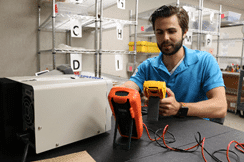Quality programs frequently require instrumentation used to obtain measurements (to determine conformance to a governing specification) to be calibrated and verified for accuracy, but oftentimes do not provide the frequency or methodology; only that it must be done. This brief article explains calibration, verification of accuracy, and adjustment, and contains a convenient reference table listing many of the instruments that are used to verify the quality of surface preparation and coating installation work, along with the frequency in which calibration should be performed. It also provides direction on how to verify accuracy and assess functionality prior to use.
Background

An article posted to KTA University in February 2017 by Matthew Fajt, “Calibration, Verification of Accuracy and Adjustment… Synonyms or Differences in Terminology?” clarified the differences between the terms and processes used to make certain inspection instruments are operating properly. In the article, he described calibration as the high-level, controlled and documented process (performed by the gage manufacturer, their authorized agent, or by an accredited calibration laboratory) of obtaining measurements on traceable calibration standards over the full operating range of the gage, then making the necessary gage adjustments (as required) to correct any out-of-tolerance conditions. He went on to state that calibration must be performed in a controlled environment that is not typically found in a blast/paint shop or in the field.
Verification of accuracy, however, is performed by the gage/instrument operator and does not need to be performed in a controlled environment. One ASTM standard[1] defines verification of accuracy as, “obtaining measurements on coating thickness standards, comprised of at least one thickness value close to the expected coating thickness, prior to gage use for the purpose of determining the ability of the coating thickness gage to produce thickness results within the gage manufacturer’s stated accuracy.”
Based on the accuracy verification process, subsequent adjustment to the instrument may be necessary to compensate for shop or field conditions. The table below lists some common coating inspection instruments and the corresponding frequency of calibration and verification of accuracy intervals. It also provides direction on ways to verify proper functionality prior to use.

3Tube thermometers: Certificates of accuracy are provided with most tube thermometers and accuracy can be verified in the shop/field by placing a traceable thermometer next to the tube thermometers (covered to protect them from drafts/air flow) and permitted to stabilize for a minimum of 30 minutes. Dial-type surface temperature thermometers and stem-type paint thermometers can also be verified for accuracy using this method. The readings are compared to the traceable thermometer. Note that this procedure is only valid for one temperature point (that of the traceable thermometer) unless a variable temperature chamber is used.
4Wet Film Thickness (WFT) gage: A Certificate of Calibration is provided with one manufacturer’s notch-type WFT gage (KTA WFT Gage); however, the gage cannot be recertified. Annual replacement is recommended for the KTA WFT Gage. Also, the accuracy of the gage cannot be verified in the shop/field.
5Certified coated thickness standards: A Certificate of Calibration is provided when the standards are purchased new. The only way to verify they remain in tolerance upon use is to measure them with a calibrated dry film thickness gage and determine whether the readings are within the combined tolerance of the gage and standards (sum the squared tolerance of the gage and standards, then calculate the square root). For example, if the tolerance of the gage is 3% and the tolerance of the standards is 5%, the combined tolerance is 6%. If the calibrated dry film thickness gage reads 9.4-10.6 mils on a 10-mil coated standard, the gage/coated standard combination is considered accurate.
6Certified shims: A Certificate of Calibration is provided when the shims are purchased new. The thickness can be verified with a calibrated spring micrometer, provided the load on the anvils of the micrometer does not damage thinner shims (i.e., shims less than 5 mils).
7Light meter: Most light meters that are used to assess the amount of ambient light (natural and/or man-made) in a space come with a manufacturer’s Certificate of Accuracy. However, there are no common practices for verifying accuracy in the shop or field.
8Tape measure: At least one manufacturer (Starrett) provides a Certificate of Calibration with their tape measures. Verification of accuracy can be performed using a secondary standard, such as a piece of angle iron bolted to a wall and the length of the angle iron sighted-in using a precision laser. Alternatively, a tape measure with a Certificate of Calibration may be designated solely for verifying the accuracy of other tape measures and stored/secured to prevent any other use.
Summary
Instruments that are used to verify quality must be calibrated and verified for accuracy, when feasible. Instrumentation is calibrated by the equipment manufacturer or an accredited calibration laboratory, while the instrument user is responsible for verifying accuracy. Many of the instruments used to verify the quality of surface preparation and coating application can be calibrated and verified for accuracy; several can be adjusted by the user as needed. Confidence in any data set is realized only when the measurements are obtained using instrumentation that is maintained within the manufacturer’s stated tolerance. Additionally, the functionality of an instrument should be verified prior to each use, when applicable.
[1] ASTM D7091, Standard Practice for Nondestructive Measurement of Dry Film Thickness of Nonmagnetic Coatings Applied to Ferrous Metals and Nonmagnetic, Nonconductive Coatings Applied to Non-Ferrous Metals
[2] No mandated frequency is provided by the manufacturer. Interval listed is considered “best practice.”


